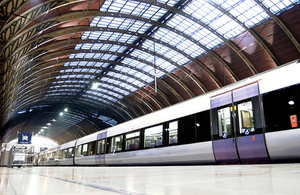CMA signals route for greater rail competition
The CMA has outlined how greater competition could benefit rail passengers on Great Britain’s major intercity routes.

A train waiting at a platform in a railway station
In a report published today and sent to the Secretary of State for Transport, the Competition and Markets Authority (CMA) has concluded a project looking at the possibilities for introducing greater competition between passenger train operators.
The CMA started the project in January 2015 and published an interim report in July 2015, which detailed how greater competition could potentially benefit passengers.
Currently, the benefits of competition in passenger rail services are secured primarily by the award of franchises to operators through competition ‘for’ the market. Although the report notes that this process has delivered positive results, the CMA’s report has identified a range of benefits that could arise from allowing other operators to run competing services against the existing franchise operators.
Examples of such ‘on-rail’ competition in Great Britain (GB) have mainly occurred on the East Coast main line where ‘open access’ operators like Grand Central and First Hull Trains have been able to run competing services. Although these services represent less than 1% of passenger miles, the evidence of resulting benefits has been underlined by examples of competition between passenger rail operators in other European countries and in other transport markets such as the GB rail freight sector, air transport and airports.
Together this evidence suggests that an increase in on-rail competition could result in benefits for passengers and taxpayers, such as:
- lower fares and growth in passenger numbers
- greater incentives for operators to improve service quality and innovate
- greater efficiency by train operators
- more effective use of network capacity
The CMA considers that increasing the number of open access services or splitting franchises offers the most immediate benefits from increased competition – but that a move towards a system of multiple licensed operators replacing franchises could also be worth consideration in the future. The report says that the potential for such competition exists predominantly on the 3 main intercity routes in GB – namely the East and West Coast main lines and the Great Western route, which carry over 90 million passenger journeys per year.
In order to grant more operators access, the CMA proposes that competing open access operators should be able to make more of a contribution than at present in terms of track access charges and through a Public Service Obligation (PSO) levy to contribute to the funding of important but unprofitable services, such as those in rural areas. This would help cover any fall in the premiums paid to government that might result from increased competition.
Although these proposals will not affect current franchises and imminent franchise awards, action is needed now given the steps required to implement the options for reform.
Alex Chisholm, CMA Chief Executive said:
We’ve found that there is strong evidence, both here and abroad, of the benefits that the introduction of competition on mainline intercity routes can bring. Where competing operators have been given the opportunity, the need to attract passengers who have a choice can mean lower fares, new routes and destinations, more innovations and flexible ticketing. Not only does this offer a better deal for existing travellers but it can increase overall passenger numbers by attracting new customers to the railways.
In a more competitive environment companies will push to be more efficient and for there to be better use of existing capacity – so there are benefits for both the network and the taxpayer who helps subsidise the railways.
There are legitimate concerns about the impact that greater competition might have on the income received by government from franchise operators but so far that concern has been tackled in a way that hinders new entrants. We think a better way would be to have a level playing field – where competing operators are able to make more of a contribution to network costs and to funding unprofitable services. In return they would get more freedom to compete for business against the franchise operator.
There’s a real chance here to extend these benefits across a wider area and the timing is undoubtedly right to push for change. We hope all those involved with the future of the rail network will look at our report carefully and seize the opportunity.
In producing this report, the CMA has liaised with a wide range of interested groups, including the Office of Rail and Road, Network Rail, Department for Transport, Transport Scotland, the Department for Business, Innovation & Skills, HM Treasury, international rail regulators, passenger and freight operators, consumer groups like Which? and Transport Focus, as well as academics and other experts specialising in the sector.
Notes for editors
- The CMA is the UK’s primary competition and consumer authority. It is an independent non-ministerial government department with responsibility for carrying out investigations into mergers, markets and the regulated industries and enforcing competition and consumer law.
- For more information on the CMA see our homepage or follow us on Twitter @CMAgovuk, Flickr and LinkedIn.
- Enquiries should be directed to Rory Taylor (rory.taylor@cma.gsi.gov.uk, 020 3738 6798).